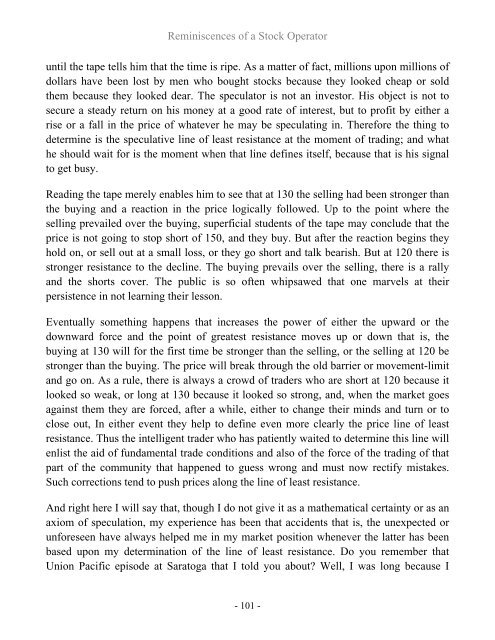You also want an ePaper? Increase the reach of your titles
YUMPU automatically turns print PDFs into web optimized ePapers that Google loves.
Reminiscences of a Stock Operator<br />
until the tape tells him that the time is ripe. As a matter of fact, millions upon millions of<br />
dollars have been lost by men who bought stocks because they looked cheap or sold<br />
them because they looked dear. The speculator is not an investor. His object is not to<br />
secure a steady return on his money at a good rate of interest, but to profit by either a<br />
rise or a fall in the price of whatever he may be speculating in. Therefore the thing to<br />
determine is the speculative line of least resistance at the moment of trading; and what<br />
he should wait for is the moment when that line defines itself, because that is his signal<br />
to get busy.<br />
Reading the tape merely enables him to see that at 130 the selling had been stronger than<br />
the buying and a reaction in the price logically followed. Up to the point where the<br />
selling prevailed over the buying, superficial students of the tape may conclude that the<br />
price is not going to stop short of 150, and they buy. But after the reaction begins they<br />
hold on, or sell out at a small loss, or they go short and talk bearish. But at 120 there is<br />
stronger resistance to the decline. The buying prevails over the selling, there is a rally<br />
and the shorts cover. The public is so often whipsawed that one marvels at their<br />
persistence in not learning their lesson.<br />
Eventually something happens that increases the power of either the upward or the<br />
downward force and the point of greatest resistance moves up or down that is, the<br />
buying at 130 will for the first time be stronger than the selling, or the selling at 120 be<br />
stronger than the buying. The price will break through the old barrier or movement-limit<br />
and go on. As a rule, there is always a crowd of traders who are short at 120 because it<br />
looked so weak, or long at 130 because it looked so strong, and, when the market goes<br />
against them they are forced, after a while, either to change their minds and turn or to<br />
close out, In either event they help to define even more clearly the price line of least<br />
resistance. Thus the intelligent trader who has patiently waited to determine this line will<br />
enlist the aid of fundamental trade conditions and also of the force of the trading of that<br />
part of the community that happened to guess wrong and must now rectify mistakes.<br />
Such corrections tend to push prices along the line of least resistance.<br />
And right here I will say that, though I do not give it as a mathematical certainty or as an<br />
axiom of speculation, my experience has been that accidents that is, the unexpected or<br />
unforeseen have always helped me in my market position whenever the latter has been<br />
based upon my determination of the line of least resistance. Do you remember that<br />
Union Pacific episode at Saratoga that I told you about? Well, I was long because I<br />
- 101 -


